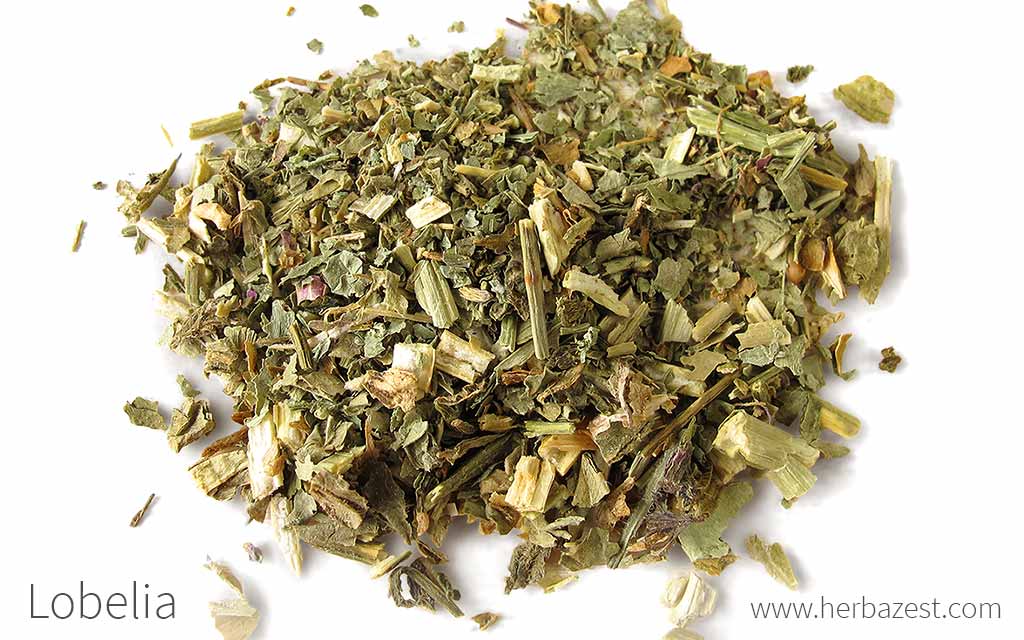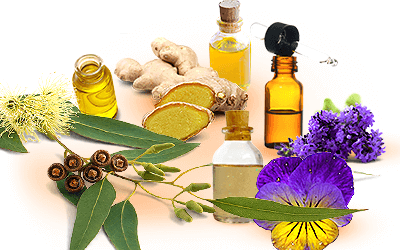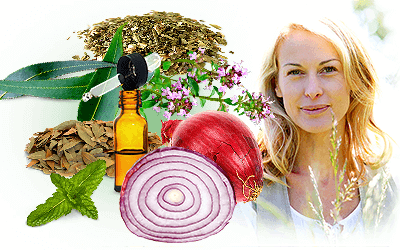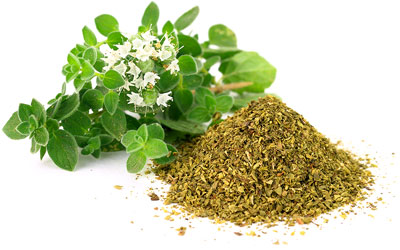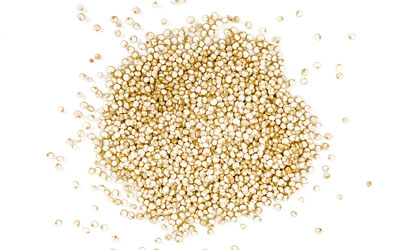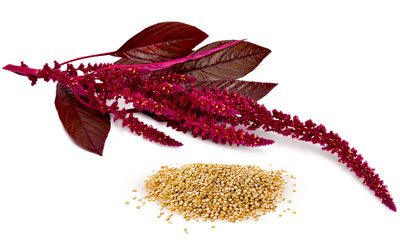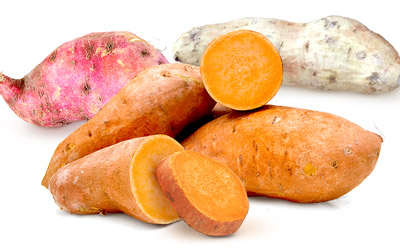Lobelia is an herb native to North America, where it has been used for centuries by Native Americans to treat coughs and chest pains, as well as to induce vomiting. Today, lobelia is still used in herbal remedies; however, most people are unaware of its health benefits.
Lobelia Medicinal Properties
- Medicinal action Antidepressant, Expectorant
- Key constituents Alkaloids (lobelin), triterpenoids (beta-amyrin palmitate)
- Ways to use Capsules, Hot infusions/tisanes, Smoked
- Medicinal rating (1) Very minor uses
- Safety ranking Safety undetermined
Health Benefits of Lobelia
Lobelia contains resins, lipids, gums, and alkaloids, which, when combined, can help relax muscles. This has led to its traditional usages, especially its role as a nicotine substitute. Lobelia's medicinal uses include:
Alleviating respiratory symptoms. Due to its expectorant and antispasmodic properties, lobelia promotes the expulsion of phlegm, which is useful for treating respiratory diseases such as bronchitis.
Reducing stress and depression. Lobelia's dopaminergic effects can help reduce stress levels and combat depressive symptoms by calming the nervous system.
Lobelia has been popularly consumed to reduce withdrawal symptoms in people trying to quit smoking and overcome substance abuse; however, research in this area is limited, and further investigation is necessary to corroborate these uses.1
Lobelia is a powerful emetic, which means it can induce vomiting to expel expel harmful substances from the body. Additionally, lobelia's calming effects can help reduce pain and muscle spams.
How It Works
Lobelia contains fourteen different compounds that give it medicinal properties, the most prevalent of which is obeline, gums, resins, lipids, essential oil, and lobelic acid. Of the numerous alkaloids found in lobelia, lobeline is the most pertinent, as it acts as a respiratory stimulant and improves the cough reflex, facilitating the expulsion of phlegm and helping to clear the lungs.2
Lobelia's alkaloids and a triterpenoid called beta-amyrin palmitate exert dopaminergic and antidepressant effects by hindering cell proliferation in the hippocampus and stimulating dopamine release in the brain.3,4,5
Lobelia's emetic properties have been traditionally used as an antidote for poisoning and intoxication. In high doses, its alkaloids induce vomiting to help eliminate harmful substances.
Herbs with anti-inflammatory and expectorant properties include elecampane, eucalyptus, myrtle and coltsfoot, while calming and stress-reducing properties are found in lavender, lemon balm, lemon verbena, and passion flower.
Lobelia Side Effects
Lobelia should be consumed under medical supervision, as lobelin, its main active compound, can be potentially toxic when taken orally in high doses. Side effects may include profuse sweating, nausea, vomiting, diarrhea, tremors, rapid heartbeat, mental confusion, convulsions, hypothermia, and coma.
Cautions
Individuals who suffer from high blood pressure, heart disease, liver disease, kidney disease, tobacco sensitivity, paralysis, seizure disorder, difficulty breathing, or those recovering from shock should not take lobelia.
Lobelia can worsen symptoms of ulcers, Crohn's disease, irritable bowel syndrome (IBS), or intestinal infections.
Lobelia should not be taken during pregnancy or breastfeeding.

How to Consume Lobelia
- Edible parts Leaves
- Edible uses Flavoring, Beverage
- Taste Mildly bitter
The most effective way to obtain lobelia's health benefits is through medicinal consumption, where quantities can be easily controlled. Lobelia can be taken orally or applied topically.
Natural Forms
Infusion. Lobelia hot tea, the main preparation, has numerous medicinal benefits, including reversing water retention due to its emetic properties. It also eases withdrawal symptoms for those trying to give up tobacco products.
Herbal Remedies & Supplements
Extract. In an extract form, lobelia helps expel phlegm from the respiratory system due to its expectorant properties, clearing the airways.
- Essential oil. Lobelia essential oil, once diluted in water, can be ingested to treat respiratory congestion, such as in bronchitis.
Tincture. In this concentrated medicinal form, lobelia must be diluted in water to take advantage of its health benefits, including emetic effects in cases of poisoning or intoxication.
Ointment. Lobelia salves are applied topically to relieve muscle spasms.
Capsules. Lobelia capsules can expel phlegm from the respiratory system through its expectorant properties. It also works as an antidepressant.

Growing
- Harvested parts Leaves
Lobelia, which can be either annual or biennial, is an excellent choice for decorating garden borders, window boxes, and hanging baskets. It's a relatively easy plant to grow and thrives in cool, temperate climates.
Growing Guidelines
Lobelia plants prefer clay-based soil and thrive in full sun or partial shade.
Lobelia seeds can be sown directly in the garden or started indoors for later transplanting, as they are vulnerable to the elements.
Once established, lobelia plants require very little maintenance. However, they should be watered frequently during periods of drought.
For optimal growth, apply liquid fertilizer every four to six weeks.
Flowers typically bloom in the middle of summer.
Additional Information
- Other uses Repellent
Plant Biology
Scientifically known as Lobelia inflata, lobelia is an annual or biennial plant that grows anywhere from 6 to 40 inches (15 - 100 cm) tall, with stems covered in tiny hairs. Lobelia's leaves are typically three inches (8 cm) long, ovate, and toothed. It has delicate and elegant flowers, which can be purple, pink, white, or blue.
Classification
Lobelia is a member of the Campanulaceae, or bellflower family, which comprises approximately 2,000 species spread over 70 genera, with a high concentration in the Northern Hemisphere.
Related Species and Varieties of Lobelia
Lobelia inflata is the most popular species of the Lobelia genus, which includes about 360 to 400 species of flowering plants. These species consist of a significant number of large and small annuals, perennials, and shrubby plants that grow in a variety of habitats. While many of the Lobelia species may appear dissimilar, they can all be identified through their simple, alternate leaves and two-lipped tubular flowers, each with five lobes. The lower three lobes fan out, while the upper two lobes are typically erect.
There are numerous Lobelia hybrids, one of the most well-known being Lobelia speciosa, which is a hybrid of L. fulgens, L. cardinalis, and L. siphilitica.
Historical Information
For most of its history, lobelia was used medicinally in many different Native American tribes. The Cherokee tribe mashed up the root and dried the leaves, smoking the mixture to relieve coughing and chest pains. The Iroquois tribe used lobelia to treat venereal diseases, ulcers, and leg sores. The Crows used it in religious ceremonies.
In the 18th century, lobelia was introduced to Europe, where Samuel Thomson, a botanist and healer, began using the herb for medicinal purposes, namely to treat fevers, rheumatism, and cough. However, Thomson faced significant scrutiny, as lobelia is toxic when taken in excess, and he was accused of murdering Ezra Lovette by poisoning, though he was later acquitted.
By the 19th century, physicians began recommending lobelia as a way to remove toxins from the body through vomiting.
Lobelia is sometimes called 'Indian Tobacco' or 'pukeweed.'
Economic Data
The United States remains the largest producer of lobelia, which is commercially cultivated only for medicinal purposes. Britain is the largest market for lobelia, importing over 30 million pounds each year, although it is also popular in other parts of Western Europe.
Other Uses of Lobelia
Insect repellent. The herb can be burned to act as a bug repellent, keeping away insects such as mosquitoes.
Gardening. Some North American gardeners also grow it as an ornamental plant.
Sources
- Biochemical Pharmacology, Lobeline effects on tonic and methamphetamine-induced dopamine release, 2007
- British Broadcasting Corporation, Lobelia
- Frontiers in Pharmacology, Beyond Alkaloids: Novel Bioactive Natural Products From Lobelia Species, 2021
- Indian Journal of Pharmaceutical Sciences, An antidepressant principle of Lobelia inflata L. (Campanulaceae), 1994
- Life Sciences, A possible mechanism of antidepressant activity of beta-amyrin palmitate isolated from Lobelia inflata leaves in the forced swimming test, 1993
- Purdue University, Lobelia
- The Clinician's Handbook of Natural Medicine, Bronchitis and pneumonia, 2016
- The Journal of Pharmacy and Pharmacology, Pharmacological Properties of β-Amyrin Palmitate, a Novel Centrally Acting Compound, Isolated from Lobelia inflata Leaves, 1993
- The Medicinal Herb Gardens at ONU, Lobelia Inflata
- Encyclopedia of Herbal Medicine, p. 112
- Medicinal Plants of the World, page 194
Footnotes
- Cochrane Database Systematic Review. (2012). Lobeline for smoking cessation. Retrieved October 3, 2024, from: https://www.ncbi.nlm.nih.gov/pmc/articles/PMC7043274/
- EXCLI Journal. (2011). Essential oil composition and antimicrobial activity of Lobelia pyramidalis Wall. Retrieved October 4, 2024, from: https://www.ncbi.nlm.nih.gov/pmc/articles/PMC5611621/
- International Journal of Biological Sciences. (2018). Role of Plant Derived Alkaloids and Their Mechanism in Neurodegenerative Disorders. Retrieved October 4, 2024, from: https://www.ncbi.nlm.nih.gov/pmc/articles/PMC5859479/
- Indian Journal of Pharmaceutical Sciences. (1992). An antidepressant principle of Lobelia inflata L. (Campanulaceae). Retrieved October 4, 2024, from: https://pubmed.ncbi.nlm.nih.gov/1403691/
- Life Sciences. (1993). A possible mechanism of antidepressant activity of beta-amyrin palmitate isolated from Lobelia inflata leaves in the forced swimming test. Retrieved October 4, 2024, from: https://pubmed.ncbi.nlm.nih.gov/8423710/

